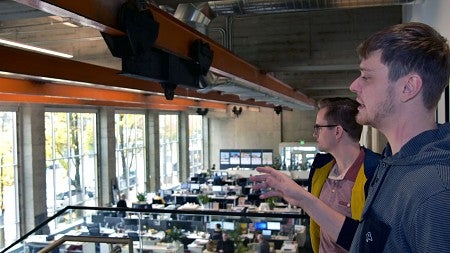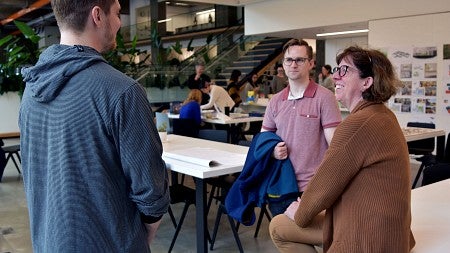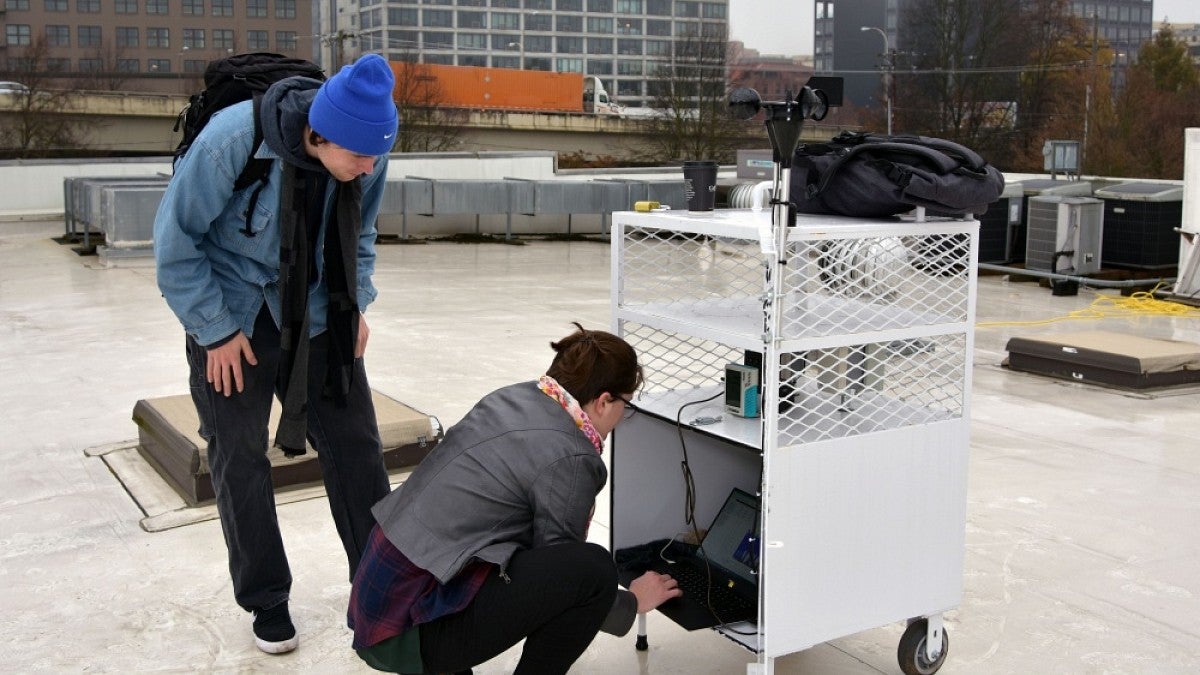Elise Braun set her coffee and backpack down on top of a white metal cage that houses a weather station and went to work unlocking its door. A morning fog made the rooftop slippery and cold. On her right was a view of a northwest Portland neighborhood, with spots of yellow and orange trees peppering the hillside of Forest Park.
But she is more concerned with the scene to her left – Interstate 405. The freeway that cuts around downtown Portland is just a couple of blocks away and elevated as it comes off the Fremont Bridge. It carried a steady stream of vehicles. The low whine from cars was punctuated by rumbles of buses and the airbrakes of tractor-trailers.
It’s the emissions from those vehicles that drives the project for the class “Design the Unseen: Research Investigating Health + Energy in Building Design,” for Master of Architecture track II students in the School of Architecture & Environment at the University of Oregon Portland campus. Student teams were matched with architecture firms to explore design challenges related to human and planetary health.
“We’re studying the pollutants in the area and if they’re coming into the natural ventilation in the space below,” Braun said. “We’re measuring the particle count and the weather conditions out here with this weather station, so we can compare it to what we’re seeing on the inside.”
Braun and her teammates, Thomas Cooper and Marsie Surguine, partnered with Opsis Architecture, which works in sustainable design. The office uses passive ventilation, so air circulates through openings such as windows, doors and vents, rather than being forced in through a mechanical system.
The students wanted to find out how much of the freeway pollutants were entering the workspace below and if low-cost remedies could reduce the amount of contaminants reaching employees. After collecting a week’s worth of data from the weather station and inside sensors, the students constructed a shelf of air-filtering plants to see how the data changed.
Designing for health was a focus of architecture in the early to mid 1900s, said Mark Fretz, associate director of outreach and research assistant professor for the School of Architecture & Environment and the class instructor. There was a belief that health could be improved through building design, but as the world experienced an oil crisis and saw the effects of climate change, design focus shifted to energy conservation.

Humans evolved by being outside most of the day, but now, in a relatively short period, people spend 90 percent of their time indoors and increasingly more in front of computers and mobile devices.
The class, which also had students from the master of science in architecture and bachelor of architecture programs, had access to the Energy Studies in Buildings Laboratory in UO Portland’s White Stag Block to test out their theories and data. The lab has a climate chamber, mirrored-box artificial sky, heliodon and a wind tunnel, which allow researchers, students and industry partners to develop and test building solutions for health and sustainability.
“This class gives students the tools to visualize analytics and discover innovative solutions,” Fretz said. “To do this, we partnered with several architecture firms in Portland to help frame research, guide the process and give us a living lab for the research setting.”
Jordan Pieper and Nico Pici, graduate-level architecture students, surveyed an open space at SRG Partnership in downtown Portland while employees worked at their desks. A grand wall of east-facing windows filled the space with mid-morning light. About a dozen employees had green disks clipped to their shirts. They had worn them during working hours for a week to capture light intensity and spectrum as they went about their days.

Other student teams looked at the effect of daylight and electric light on bacteria, how sound affects well-being, the visual use of mass timber for improving acoustic perception, carbon dioxide and cognition in open offices, affordable housing and daylighting design for circadian stimulation, and the built environment’s effect on the urban watershed and human health.
“Architecture timelines are fast and designed with the best available evidence,” Fretz said. “Our graduate students need to know how to find evidence, validate and apply it, and collaborate internally and across disciplines.”
Learn more about healthy built environments and designing for the unseen.
—By Heidi Hiaasen, University Communications


